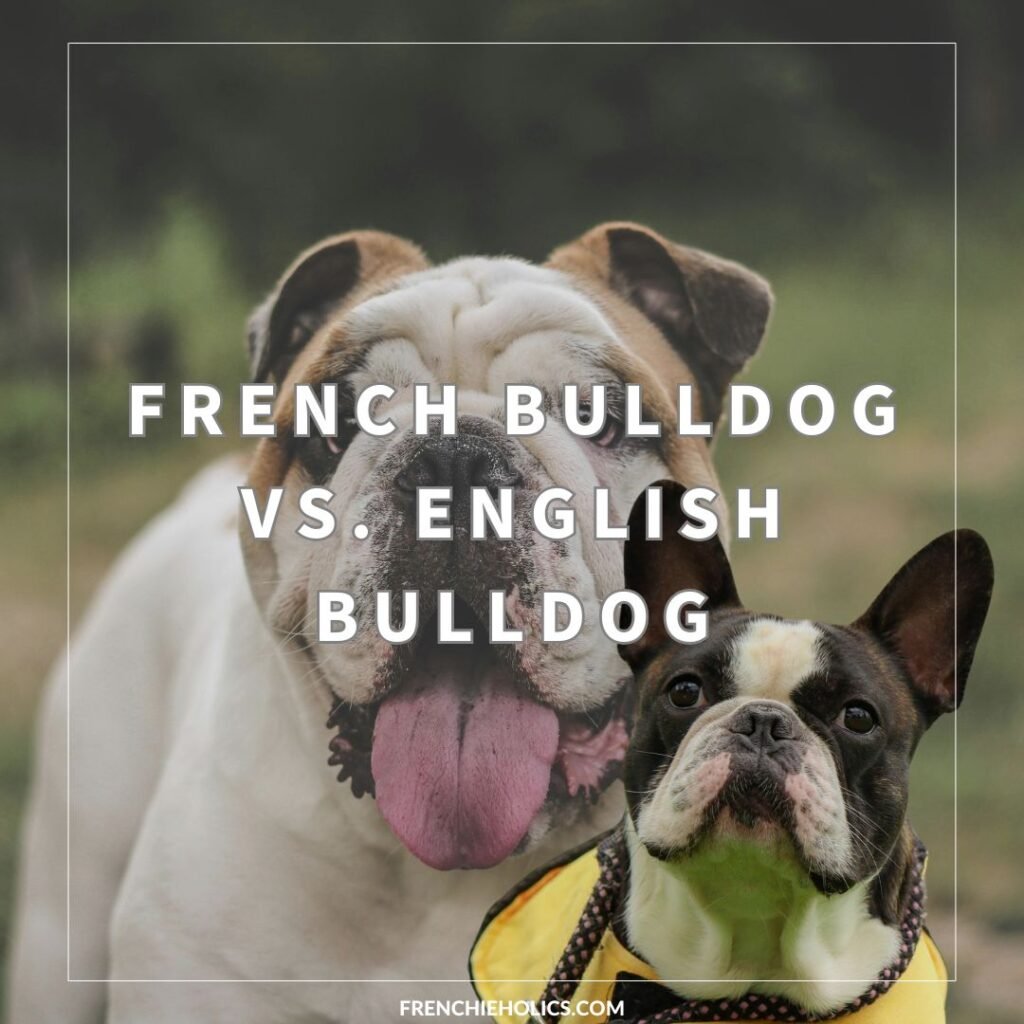Those adorable wrinkled faces, stocky bodies, and undeniable charm have made both French Bulldogs and English Bulldogs among the most beloved dog breeds in America. While they share a similar name and some distinctive physical traits, these two breeds offer quite different experiences for their human companions.
Both breeds trace their lineage back to the same bulldog ancestors from the British Isles, originally bred for the now-outlawed sport of bull-baiting. However, over time, selective breeding transformed these once-fierce dogs into the affectionate companions we know today:
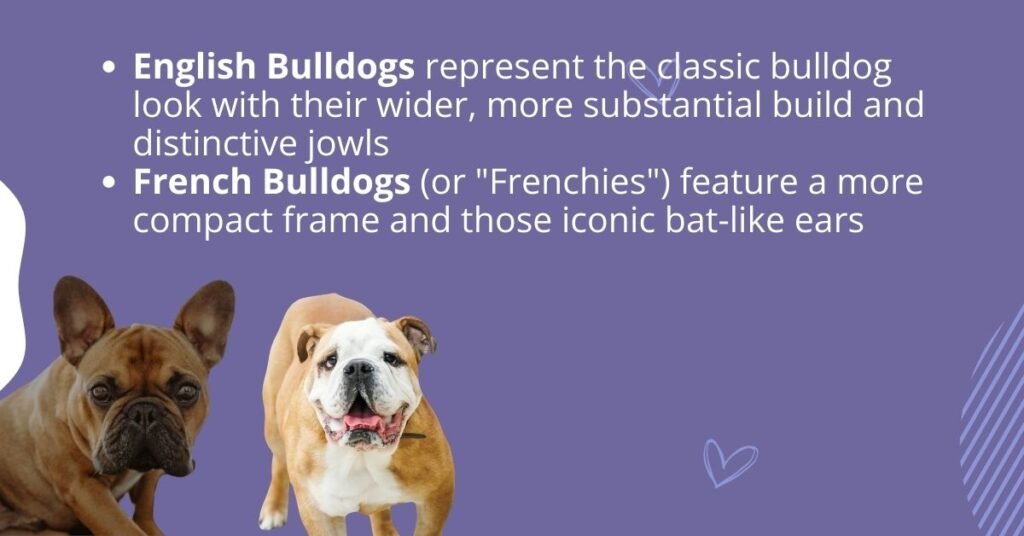
- English Bulldogs represent the classic bulldog look with their wider, more substantial build and distinctive jowls
- French Bulldogs (or “Frenchies”) feature a more compact frame and those iconic bat-like ears
If you’re considering bringing one of these charismatic companions into your home, understanding their differences is crucial to making the right choice for your lifestyle and preferences.
Throughout this article, we’ll explore:
- Physical characteristics and appearance differences
- Temperament and personality traits
- Training and exercise requirements
- Health considerations and care needs
- Cost of ownership and long-term commitment
- Lifestyle compatibility factors
By the end, you’ll have a comprehensive understanding of what makes each breed unique, helping you determine whether an English Bulldog’s dignified calm or a French Bulldog’s playful spirit is the perfect match for your home. Let’s dive into these charming breeds and discover which bulldog variation might become your new best friend.
Breed History and Origins
Both French and English Bulldogs share a common ancestry rooted in the British Isles, where they were originally bred for bull-baiting in the 1500s. Over time, as blood sports were outlawed, breeders shifted focus toward developing companion animals, giving rise to the distinct English and French Bulldog breeds we know today. While the English Bulldog remained in Britain, the smaller bulldogs that accompanied lace makers to France evolved into the playful and compact French Bulldog.
The Common Bulldog Ancestry
The story of both French and English Bulldogs begins in the British Isles during the 1500s, where their ancestors were bred for a purpose far removed from today’s companion dogs. These early bulldogs were developed specifically for the blood sport of bull-baiting – a cruel entertainment where dogs were trained to grab bulls by their snouts and pin them to the ground.
These original bulldogs needed to be:
- Extremely powerful and muscular
- Low to the ground (“playing low”) to avoid the bull’s horns
- Tenacious and nearly insensitive to pain
- Equipped with a wide jaw and short muzzle for a stronger grip
When the Cruelty to Animals Act of 1835 finally made bull-baiting illegal, the future of bulldogs hung in the balance. Thankfully, dog enthusiasts recognized the breed’s potential beyond fighting and began selective breeding to transform the aggressive bull-baiter into a gentle companion animal.
English Bulldog Development
After bull-baiting was outlawed, breeders worked diligently to reshape the English Bulldog’s temperament. They focused on:
- Eliminating the aggressive traits while maintaining the distinctive physical appearance
- Developing a calmer, more stable disposition suitable for family life
- Preserving the breed’s courageous nature without the fighting instinct
By 1866, these efforts had so transformed the breed that it gained recognition by the American Kennel Club. Today’s English Bulldog represents what many consider the “classic bulldog” with its substantial build, heavy wrinkles, and dignified demeanor – quite different from its fighting ancestors but maintaining the iconic bulldog appearance.

French Bulldog Development
The French Bulldog’s story takes an interesting turn in the 1800s. While they began in England as smaller bulldogs, their journey to becoming the beloved “Frenchie” involved:
- Popularity among lace workers in Nottingham, England, who kept them as lap dogs and ratters
- Migration to northern France when these craftspeople relocated during the Industrial Revolution
- Further refinement by the French, who appreciated the smaller bulldogs’ companionable nature
- Development of their distinctive bat ears, which became a hallmark of the breed
From the French countryside, these charming dogs made their way to Paris, becoming fixtures in cafés and gaining popularity among society. Eventually, visiting Americans fell in love with these compact bulldogs and brought them to the United States. Their rise in popularity has been remarkable, culminating in them becoming America’s most popular dog breed today, surpassing even the Labrador Retriever’s long-held position.
Physical Characteristics and Appearance
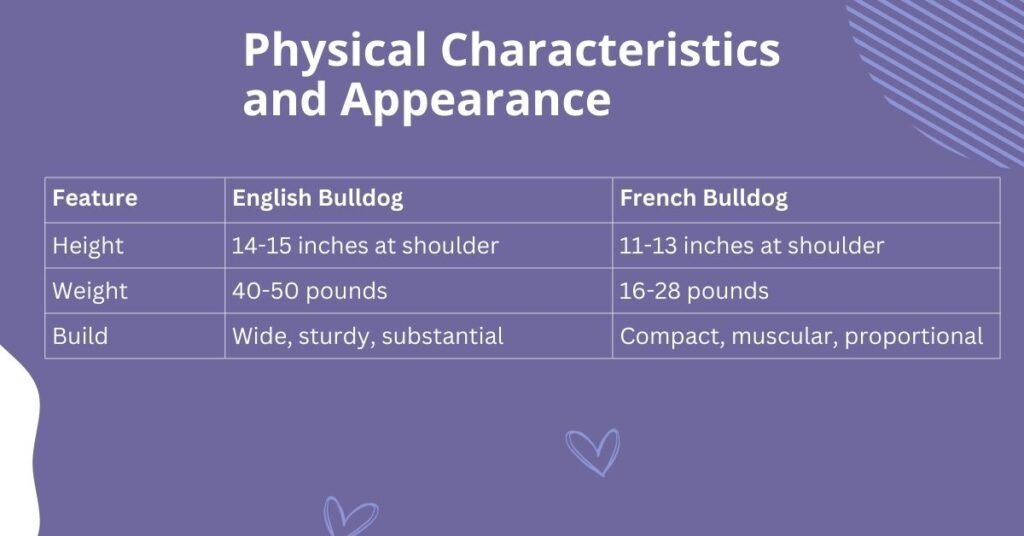
When comparing French and English Bulldogs, their physical differences become apparent despite their shared ancestry. Understanding these distinctions can help you identify each breed and decide which aesthetic appeal aligns with your preferences.
Size and Build Comparison
The most noticeable difference between these breeds is their size and overall build:
| Feature | English Bulldog | French Bulldog |
| Height | 14-15 inches at shoulder | 11-13 inches at shoulder |
| Weight | 40-50 pounds | 16-28 pounds |
| Build | Wide, sturdy, substantial | Compact, muscular, proportional |
The English Bulldog presents a more imposing figure with its broad shoulders, wide stance, and substantial mass. Their body structure features a distinctly low center of gravity with a deep chest and sturdy legs, creating the classic bulldog silhouette that’s instantly recognizable.
In contrast, the French Bulldog offers a more compact and proportional package. While still muscular, Frenchies have a lighter frame and appear more agile than their English cousins. Their back remains relatively level (compared to the English Bulldog’s more pronounced slope), and their smaller size makes them ideal for apartment living and easier handling.
Distinctive Facial Features
Both breeds share the characteristic flat face of brachycephalic dogs, but their facial structures differ significantly:
- English Bulldog:
- Broader, meatier head with a more pronounced stop
- Small, rose-shaped ears that fold back
- Heavier wrinkles across the face, particularly the forehead
- Distinctive, pendulous jowls hanging from both sides of the mouth
- Slightly smaller eyes set wider apart
- More prominent underbite
- French Bulldog:
- More proportional, square head
- Distinctive large, erect “bat ears” that stand upright
- Fewer facial wrinkles, concentrated mainly between the eyes
- Cleaner facial lines without pronounced jowls
- Rounder, more expressive eyes
- More moderate underbite
The facial expression of each breed conveys different characteristics—English Bulldogs often appear more solemn and dignified, while Frenchies tend to have an alert, inquisitive look that matches their playful personality.
Coat Colors and Patterns
Both breeds feature short, smooth, and glossy coats that require minimal grooming, but they differ in available colors and patterns:
Shared colors between both breeds include:
- White
- Cream
- Fawn (light tan to deeper reddish-brown)
- Brindle (tiger-striped pattern)
The English Bulldog may also appear in:
- Red
- Gray (sometimes called blue)
- Various combinations with white markings
French Bulldogs offer even more variety:
- Black masks overlaying other colors
- Black and white pied patterns
- Merle (controversial in breeding circles)
- Various patterns with less symmetry than English Bulldogs
While English Bulldogs tend to display more symmetrical markings (often resembling a tuxedo pattern), French Bulldogs frequently feature more varied and asymmetrical patterns across their coat. These distinctive color combinations contribute to each breed’s unique appeal and allow prospective owners to find a dog that perfectly matches their aesthetic preferences.
Temperament and Personality
Understanding the distinct personality traits of French and English Bulldogs can help you determine which breed will better integrate with your lifestyle and family dynamics. While both make excellent companions, their temperaments differ in several key ways.
English Bulldog Personality
The English Bulldog embodies a calm, dignified presence that has earned them a reputation as gentle giants in a compact package. Their personality traits typically include:
- A loyal devotion to their family members, forming strong bonds with everyone in the household
- A surprisingly dignified demeanor that can sometimes appear almost regal despite their comical appearance
- A notable stubborn streak that can make training challenging but not impossible with consistency and positive reinforcement
- Excellent compatibility with children, showing remarkable patience and tolerance
- A generally peaceful attitude toward other pets, especially when socialized early
Perhaps most characteristic of the English Bulldog is their laid-back, low-energy approach to life. They’re perfectly content with short walks and plenty of lounging time. As one owner described, “My English Bulldog’s favorite exercise is the walk from his bed to his food bowl.”
French Bulldog Personality
The French Bulldog presents a more lively and animated character, often described as the class clown of the dog world. Their temperament typically features:
- A playful spirit that remains well into adulthood
- Sharp intelligence and an eagerness to please that makes them relatively quick learners
- A tendency to bond deeply with one particular person if not properly socialized with the entire family early on
- A mischievous side that can lead to entertaining antics and occasional trouble
- Adaptability to different living situations, making them excellent apartment dogs
Frenchies are known for their expressive personalities and almost human-like communication skills. They’ll use a combination of unique vocalizations, expressive eyes, and body language to convey their desires and opinions—and yes, they have plenty of opinions!
Which Personality Suits Your Lifestyle?
Choosing between these breeds often comes down to matching their temperament to your lifestyle:
Consider an English Bulldog if you:
- Prefer a more relaxed companion with lower exercise needs
- Have a busy household where the dog needs to be patient and adaptable
- Want a dog that’s content to lounge nearby while you work or relax
A French Bulldog might be better if you:
- Enjoy a more interactive pet that will actively engage with you
- Can dedicate time for mental stimulation and play
- Appreciate a dog with comedic timing and entertaining antics
Your living space also matters—both breeds adapt well to apartment living, but Frenchies generally require less physical space while demanding more interactive attention.
The time commitment differs slightly too. English Bulldogs are more independent and content with less activity, while French Bulldogs thrive on more frequent interaction and engagement with their people.
Training and Exercise Needs
Both French and English Bulldogs require thoughtful approaches to training and exercise that accommodate their physical limitations while meeting their behavioral needs. Understanding these requirements will help you keep your bulldog healthy, happy, and well-behaved.
English Bulldog Training
The English Bulldog brings a certain stubbornness to training sessions that can challenge even experienced dog owners. Their independent nature doesn’t mean they lack intelligence—rather, they prefer to do things on their own terms.
Effective training approaches for English Bulldogs include:
- Short sessions (5-10 minutes) to maintain their interest and accommodate their lower energy levels
- Consistent rules applied by all family members to prevent confusion
- Food motivation techniques, as most English Bulldogs are highly food-driven
- Patience and repetition, as they may need more time to master commands
When it comes to exercise, English Bulldogs require relatively modest physical activity:
- 20-30 minutes of low-impact walking daily, ideally split into two shorter sessions
- Gentle play sessions that don’t overexert them
- Regular movement throughout the day to prevent weight gain
Their exercise needs decrease with age, with many adult English Bulldogs content with brief outdoor explorations and plenty of rest time.
French Bulldog Training
The French Bulldog typically displays higher trainability thanks to their eager-to-please attitude and sharper intelligence. Their playful nature makes training sessions an opportunity for bonding.
For successful French Bulldog training:
- Use positive reinforcement consistently—they respond poorly to harsh correction
- Incorporate play elements into training to keep sessions engaging
- Establish a consistent routine with clear expectations
- Leverage their desire for social interaction as a reward
Frenchies need slightly more exercise than their English counterparts:
- 30-60 minutes of moderate activity daily
- Activities that engage their mental capabilities alongside physical exercise
- Interactive toys that challenge their problem-solving skills
Exercise Cautions for Both Breeds
As brachycephalic breeds, both French and English Bulldogs face specific exercise challenges that require careful management:
⚠️ Weather considerations:
- Avoid exercise during hot or humid conditions (temperatures above 75°F/24°C)
- Be cautious in cold weather as both breeds have limited insulation
- Schedule walks for early morning or evening during summer months
⚠️ Exercise limitations:
- Watch for signs of overexertion: excessive panting, struggling to breathe, blue-tinged tongue
- Avoid high-impact activities or those requiring prolonged exertion
- Never use neck collars for leash walking—opt for harnesses instead
When outdoor exercise isn’t feasible, consider these indoor alternatives:
- Hide-and-seek games with treats or toys
- Puzzle feeders for mental stimulation
- Gentle tug-of-war sessions
- Indoor obstacle courses using household items
Remember that appropriate exercise helps manage weight—a critical health factor for bulldogs—while insufficient activity can contribute to behavioral issues and obesity-related health problems.
Health Considerations

When considering either a French or English Bulldog, understanding their health profiles is essential for providing proper care and preparing for potential medical expenses. Both breeds face several health challenges that prospective owners should be aware of before making their decision.
Shared Health Concerns
Both French and English Bulldogs are brachycephalic breeds, meaning they have shortened facial bones resulting in their characteristic flat faces. This cute feature unfortunately brings several health challenges:
- Breathing difficulties stemming from Brachycephalic Airway Syndrome, which can include:
- Stenotic nares (narrowed nostrils)
- Elongated soft palate
- Collapsed larynx
- Narrow trachea
These respiratory issues make both breeds particularly susceptible to overheating, as they cannot cool themselves efficiently through panting. Signs of overheating include:
- Excessive panting
- Excessive drooling
- Bright red tongue or gums
- Vomiting or diarrhea
- Disorientation
Both breeds face significant weight management challenges. Their compact frames aren’t designed to carry excess weight, which can exacerbate breathing problems and joint issues. A proper diet and appropriate exercise regimen are crucial.
Additionally, their prominent eyes and shallow eye sockets make both breeds prone to various eye problems, including corneal ulcers, cherry eye, and dry eye syndrome.
English Bulldog Health Issues
The English Bulldog faces several breed-specific health concerns:
- Hip dysplasia and other joint problems are common due to their heavy build and skeletal structure
- Skin fold dermatitis occurs frequently in their deep facial wrinkles, requiring regular cleaning and maintenance
- Cardiac issues including congenital heart disease
- Thyroid disorders affecting metabolism and weight
English Bulldogs typically have a shorter lifespan of 8-10 years, which is below average for dogs of similar size. This is largely due to the numerous health challenges they face.
French Bulldog Health Issues
French Bulldogs face their own set of health challenges:
- Intervertebral disc disease and other spinal problems due to their body structure
- Cherry eye (prolapse of the third eyelid gland) and other eye conditions
- Allergies affecting the skin and ears
- Reproductive difficulties – most require artificial insemination and almost all need cesarean sections to deliver puppies
French Bulldogs typically enjoy a slightly longer lifespan than English Bulldogs, averaging 10-12 years with proper care.
Preventative Care Tips
To keep either bulldog breed as healthy as possible:
- Schedule bi-annual vet checkups to catch issues early
- Implement strict weight management through proper diet and exercise
- Maintain temperature-controlled environments, especially during summer months
- Clean facial wrinkles regularly to prevent infection
- Consider pet insurance to help with potentially costly health interventions
Being proactive about these health considerations can significantly improve both the quality and length of your bulldog’s life.
Care and Maintenance
Providing proper care for your bulldog involves understanding their specific grooming, nutritional, and environmental needs. While both French and English Bulldogs are relatively low-maintenance compared to some breeds, they do have special requirements that owners should be prepared to address.
Grooming Needs
Both bulldog varieties have short coats that require minimal brushing, but they differ in other grooming aspects:
English Bulldog grooming requirements:
- Moderate shedding year-round with seasonal increases
- Daily wrinkle cleaning required, especially in deep facial folds where moisture and debris can accumulate
- Special attention to the tail pocket area beneath the tail, which needs regular cleaning
- Weekly brushing with a soft-bristled brush to remove loose hair
French Bulldog grooming requirements:
- Lower shedding overall, though still present
- Fewer wrinkles to clean, but still need regular attention
- More manageable facial maintenance due to less pronounced facial folds
Both breeds require:
- Monthly bathing (more frequent bathing can strip natural oils)
- Weekly ear cleaning to prevent infections
- Regular nail trimming every 3-4 weeks
- Daily teeth brushing or dental treats to maintain oral health
Nutritional Requirements
Proper nutrition is crucial for maintaining healthy weight and minimizing breed-specific health issues:
English Bulldog diet:
- Approximately 2 cups of high-quality food daily, divided into two meals
- Low-grain formulas often work best to reduce gas and allergies
- Joint-supporting ingredients like glucosamine and chondroitin beneficial
French Bulldog diet:
- About 1.5 cups of food daily, adjusted for activity level and metabolism
- Smaller kibble size for easier consumption
- Moderate protein levels (21-25%) to support muscle without excessive weight gain
For both breeds:
- Avoid fillers and artificial ingredients that can trigger allergies
- Consider limited-ingredient diets if allergies develop
- Use slow-feeder bowls to prevent gulping and reduce gas
- Strict portion control is essential to prevent obesity
Living Environment Considerations
Both bulldogs thrive in controlled environments with specific accommodations:
- Apartment suitability: Both breeds excel in apartment living due to their moderate exercise needs and generally quiet nature (minimal barking)
- Temperature management:
- Keep indoor temperature between 65-75°F (18-24°C)
- Provide air conditioning during warmer months
- Use cooling mats during summer
- Have warm bedding and sweaters for winter walks
- Sleeping arrangements:
- Both breeds snore significantly (consider separate sleeping spaces if this disturbs you)
- Provide elevated beds to help with breathing and cooling
- Orthopedic bedding benefits joint health, especially for English Bulldogs
- Travel considerations:
- Many airlines restrict brachycephalic breeds due to breathing risks
- Car travel should include proper ventilation and cooling
- Consider a pet carrier or car harness designed for their compact bodies
With proper care and maintenance, both French and English Bulldogs can thrive as cherished family companions with relatively simple but specific needs.
Cost of Ownership
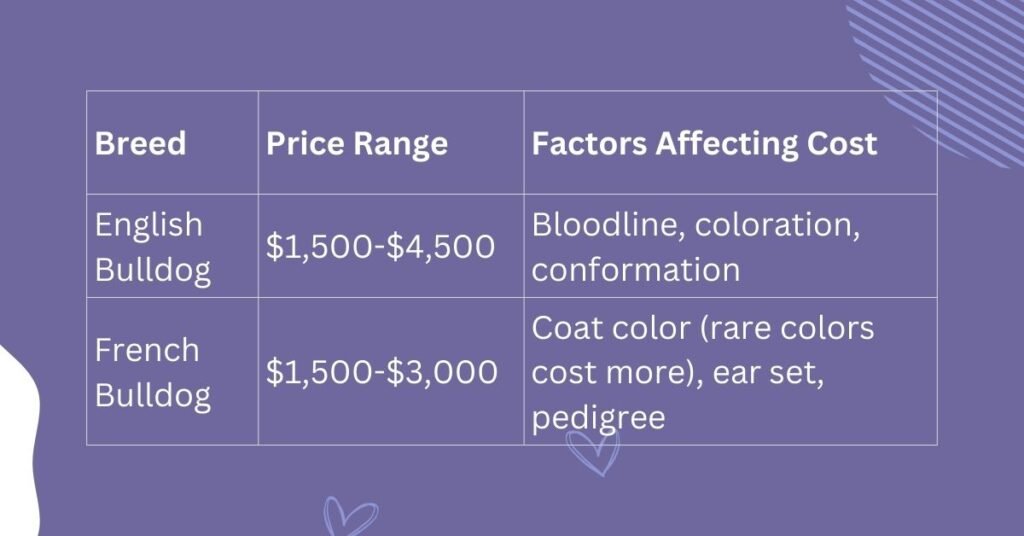
Understanding the financial commitment involved with either bulldog variety is essential for responsible pet ownership. From initial acquisition to lifetime care, these beloved companions represent a significant investment.
Initial Purchase Price
Both French and English Bulldogs command premium prices due to their popularity and specialized breeding requirements:
| Breed | Price Range | Factors Affecting Cost |
| English Bulldog | $1,500-$4,500 | Bloodline, coloration, conformation |
| French Bulldog | $1,500-$3,000 | Coat color (rare colors cost more), ear set, pedigree |
Adoption alternatives exist through breed-specific rescue organizations, where fees typically range from $300-$800. While adoption is more affordable, the availability of bulldogs in rescues is limited due to high demand.
The breeder’s reputation significantly impacts pricing. Responsible breeders who perform health testing, provide appropriate veterinary care, and breed for health rather than extreme physical traits will charge more—but potentially save you thousands in future medical expenses.
Ongoing Expenses
The daily cost of bulldog ownership includes several factors:
- Food costs:
- English Bulldogs: $40-60 monthly for quality food ($480-720 annually)
- French Bulldogs: $30-50 monthly ($360-600 annually)
- Healthcare expenses:
- Routine veterinary care: $500-700 annually for both breeds
- Pet insurance highly recommended: $50-100 monthly depending on coverage
- Medications for common issues: $200-500 annually
- Grooming needs:
- Professional grooming (optional): $30-50 per session
- Home grooming supplies: $100-150 annually
- Accessories and supplies:
- Harnesses, beds, toys, treats: $300-500 initial investment
- Replacement items: $200-300 annually
Lifetime Cost Comparison
When comparing lifetime expenses between the breeds:
- English Bulldogs typically cost more overall despite shorter lifespans (8-10 years), primarily due to higher healthcare expenses for breed-specific issues
- Lifetime cost estimate: $15,000-$25,000+ (excluding catastrophic health events)
- French Bulldogs have slightly lower lifetime costs with longer lifespans (10-12 years)
- Lifetime cost estimate: $13,000-$20,000+ (excluding major medical interventions)
Both breeds should have an emergency fund of at least $1,500-$3,000 to cover unexpected medical situations. Common procedures like cherry eye surgery ($500-800) or treatment for breathing difficulties ($1,000-3,000) can arise suddenly.
While initial purchase price differences between the breeds may be minimal, the true financial distinction lies in their potential long-term healthcare needs.
Which Breed Is Right for You? Decision Factors
Choosing between a French Bulldog and an English Bulldog involves careful consideration of your lifestyle, long-term commitment capabilities, and personal preferences. Let’s explore the key factors that should influence your decision.
Lifestyle Compatibility Assessment
The right breed for you should complement your existing lifestyle rather than requiring significant adjustments:
Activity level matching:
- Choose an English Bulldog if you prefer a more sedentary lifestyle with brief periods of low-impact activity
- A French Bulldog suits those who enjoy more regular interaction and playful engagement while still not requiring extensive exercise
Living space considerations:
- Both breeds excel in apartment living, requiring minimal outdoor space
- English Bulldogs may need slightly more interior space due to their larger size
- French Bulldogs can adapt to even small living quarters, making them ideal for urban environments
Time availability:
- English Bulldogs require less active attention but more health maintenance
- French Bulldogs need more mental stimulation and interactive playtime
- Both breeds dislike being left alone for extended periods (6+ hours)
Family dynamics:
- English Bulldogs tend to form balanced bonds with all family members
- French Bulldogs may form stronger attachments to primary caregivers
- Both breeds generally do well with respectful children and other pets
Long-term Commitment Considerations
Bulldogs represent a substantial commitment in several dimensions:
Lifespan planning:
- English Bulldogs’ shorter lifespan (8-10 years) means fewer years of commitment but more concentrated healthcare needs
- French Bulldogs’ longer lifespan (10-12 years) provides more companionship years but requires extended care commitment
Healthcare requirements:
- Both breeds need consistent veterinary care and monitoring
- English Bulldogs typically face more severe health challenges earlier in life
- French Bulldogs may develop spinal issues requiring specialized care
Financial preparedness:
- Budget for $1,000+ annually in veterinary care for either breed
- Maintain an emergency fund of $3,000+ for potential surgeries
- Consider pet insurance from puppyhood to offset unexpected costs
Lifestyle restrictions:
- Both breeds face travel limitations, especially on airlines
- Housing restrictions may apply in some rental properties
- Climate considerations affect where you can comfortably live with these heat-sensitive breeds
Making the Final Decision
After weighing the practical considerations, take these final steps:
- Meet both breeds in person to observe their temperaments firsthand
- Visit dog parks, breed-specific meetups, or dog shows
- Observe how each breed behaves in different situations
- Connect with current owners for honest insights about:
- Daily care requirements
- Unexpected challenges they’ve faced
- Realistic expectations versus common misconceptions
- Research reputable sources:
- Breed-specific rescue organizations can provide balanced perspectives
- Responsible breeders should openly discuss health challenges
- Avoid those who minimize or dismiss breed-specific concerns
- Prepare your home before bringing your bulldog home:
- Temperature control solutions
- Appropriate bedding and feeding stations
- Puppy-proofing measures
- Supplies for breed-specific care
Remember that while both breeds share certain characteristics, their individual personalities vary widely. The right bulldog for you will ultimately be the one whose specific temperament and needs align best with your lifestyle and preferences.
